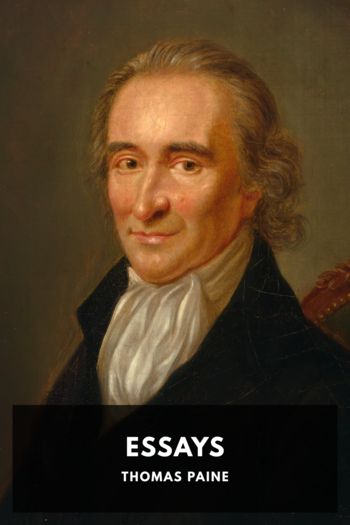The American Crisis Thomas Paine (books for 5 year olds to read themselves TXT) 📖

- Author: Thomas Paine
Book online «The American Crisis Thomas Paine (books for 5 year olds to read themselves TXT) 📖». Author Thomas Paine
By Thomas Paine.
This ebook is the product of many hours of hard work by volunteers for Standard Ebooks, and builds on the hard work of other literature lovers made possible by the public domain.
This particular ebook is based on a transcription produced for Project Gutenberg and on digital scans available at the HathiTrust Digital Library.
The writing and artwork within are believed to be in the U.S. public domain, and Standard Ebooks releases this ebook edition under the terms in the CC0 1.0 Universal Public Domain Dedication. For full license information, see the Uncopyright at the end of this ebook.
Standard Ebooks is a volunteer-driven project that produces ebook editions of public domain literature using modern typography, technology, and editorial standards, and distributes them free of cost. You can download this and other ebooks carefully produced for true book lovers at standardebooks.org.
Editor’s IntroductionThomas Paine, in his Will, speaks of this work as The American Crisis, remembering perhaps that a number of political pamphlets had appeared in London, 1775–1776, under general title of “The Crisis.” By the blunder of an early English publisher of Paine’s writings, one essay in the London Crisis was attributed to Paine, and the error has continued to cause confusion. This publisher was D. I. Eaton, who printed as the first number of Paine’s Crisis an essay taken from the London publication. But his prefatory note says: “Since the printing of this book, the publisher is informed that No. 1, or first Crisis in this publication, is not one of the thirteen which Paine wrote, but a letter previous to them.” Unfortunately this correction is sufficiently equivocal to leave on some minds the notion that Paine did write the letter in question, albeit not as a number of his Crisis; especially as Eaton’s editor unwarrantably appended the signature “C. S.,” suggesting “Common Sense.” There are, however, no such letters in the London essay, which is signed “Casca.” It was published August 9, 1775, in the form of a letter to General Gage, in answer to his Proclamation concerning the affair at Lexington. It was certainly not written by Paine. It apologizes for the Americans for having, on April 19, at Lexington, made “an attack upon the King’s troops from behind walls and lurking holes.” The writer asks: “Have not the Americans been driven to this frenzy? Is it not common for an enemy to take every advantage?” Paine, who was in America when the affair occurred at Lexington, would have promptly denounced Gage’s story as a falsehood, but the facts known to everyone in America were as yet not before the London writer. The English Crisis bears evidence throughout of having been written in London. It derived nothing from Paine, and he derived nothing from it, unless its title, and this is too obvious for its origin to require discussion. I have no doubt, however, that the title was suggested by the English publication, because Paine has followed its scheme in introducing a “Crisis Extraordinary.” His work consists of thirteen numbers, and, in addition to these, a “Crisis Extraordinary” and a “Supernumerary Crisis.” In some modern collections all of these have been serially numbered, and a brief newspaper article added, making sixteen numbers. But Paine, in his Will, speaks of the number as thirteen, wishing perhaps, in his characteristic way, to adhere to the number of the American Colonies, as he did in the thirteen ribs of his iron bridge. His enumeration is therefore followed in the present volume, and the numbers printed successively, although other writings intervened.
The first Crisis was printed in the Pennsylvania Journal, December 19, 1776, and opens with the famous sentence, “These are the times that try men’s souls”; the last Crisis appeared April 19, 1783, (eighth anniversary of the first gun of the war, at Lexington,) and opens with the words, “The times that tried men’s souls are over.” The great effect produced by Paine’s successive publications has been attested by Washington and Franklin, by every leader of the American Revolution, by resolutions of Congress, and by every contemporary historian of the events amid which they were written. The first Crisis is of especial historical interest. It was written during the retreat of Washington across the Delaware, and by order of the Commander was read to groups of his dispirited and suffering soldiers. Its opening sentence was adopted as the watchword of the movement on Trenton, a few days after its publication, and is believed to have inspired much of the courage which won that victory, which, though not imposing in extent, was of great moral effect on Washington’s little army.
Moncure Daniel Conway
The American Crisis The Crisis IThese are the times that try men’s souls. The summer soldier and the sunshine patriot will, in this crisis, shrink from the service of their country; but he that stands it now,





Comments (0)